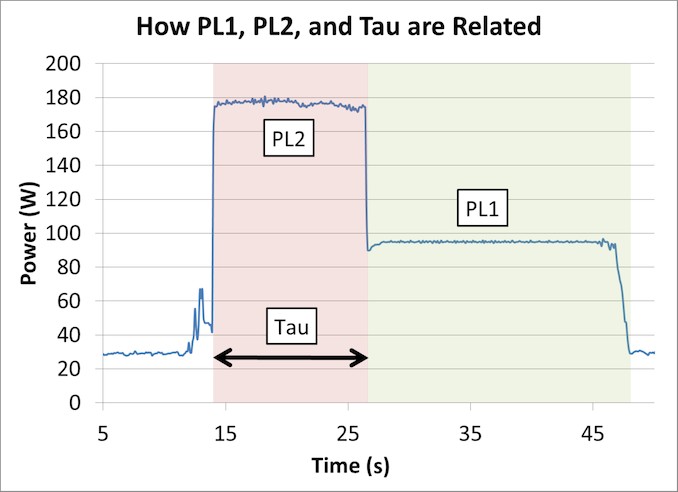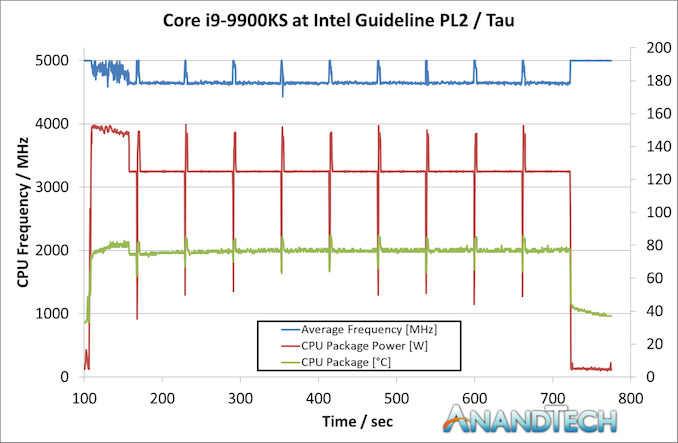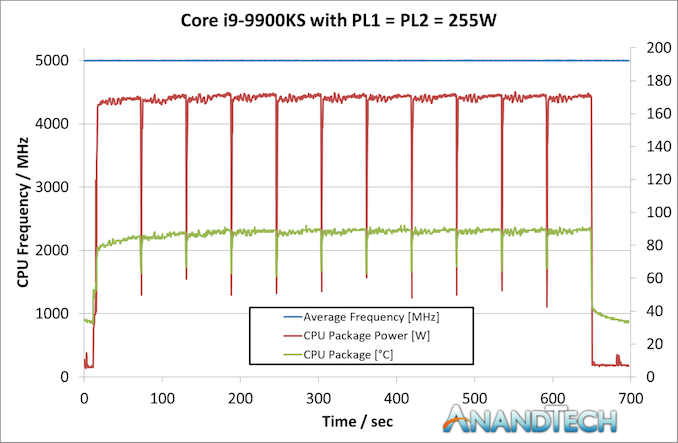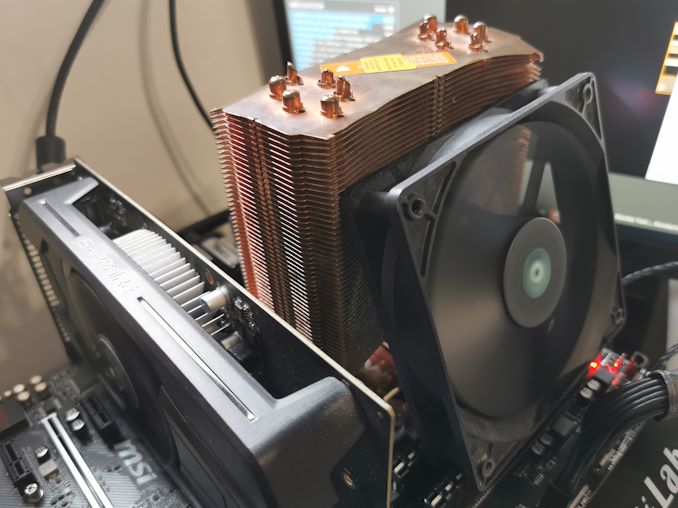The Intel Core i9-9900KS Review: The 5 GHz Consumer Special
by Dr. Ian Cutress on October 31, 2019 10:45 AM ESTGoing for Power
How to Manage 5.0 GHz Turbo
Intel lists the Core i9-9900KS processor as having a 127W TDP. As we’ve discussed at length [1,2] regarding what TDP means, as well as interviewing Intel Fellows about it, this means that the Core i9-9900KS is rated to require a cooling power of 127W when running at its base frequency, 4.0 GHz. Above this frequency, for example at its turbo frequency of 5.0 GHz, we are likely to see higher than 127W.
Now, I started saying in this review that the length of time that the processor will spend at 5.0 GHz will be motherboard dependent. This is true: Intel does not strictly define how long turbo should be enabled on any processor. It allows the motherboard manufacturer to ‘over-engineer’ the motherboard in order to help push the power behind the turbo higher and enable turbo for longer. The specific values that matter here are called PL2 (Power Limit 2, or peak turbo power limit), and Tau (a time for turbo).
For an Intel processor, each one has a ‘bucket’ of extra turbo energy. As the processor draws more power above its TDP (also called PL1), the bucket is drained to provide this energy. When the bucket is empty, the processor has to come back down to the PL1 power value, and eventually when the processor is less active below PL1, the bucket will refill. How big this bucket is depends on the value of PL1, PL2, and Tau. The bigger the bucket, the longer an Intel processor can hold its turbo frequency. Typically Tau isn’t so much as a time for turbo, but a scalar based on how big that bucket should be.

An example graph showing the effect of implementing Turbo on power/frequency
Motherboard manufacturers can set PL1, PL2, and Tau as they wish – they have to engineer the motherboard in order to cope with high numbers, but it means that every motherboard can have different long turbo performance. Intel even suggests testing processors on high-end and low-end motherboards to see the difference. Users can also manually adjust PL1, PL2, and Tau, based on the cooling they are providing.
For the Core i9-9900KS, Intel has given the PL1 value on the box, of 127 W. PL2 it says should at least be 1.25x the value of PL1, which is 159 W. Tau should be at least 28 seconds. This means, with a given workload (typically 95% equivalent of a power virus), the CPU should turbo up to 159 W for 28 seconds before coming back down to 127 W. A very important thing to note is that if the CPU needs more than 159 W to hit the 5.0 GHz turbo frequency, it will reduce the frequency until it hits 159 W. This might mean 4.8 GHz, or lower.
Despite giving us these numbers for PL1, PL2, and Tau, Intel also stated to us that they recommend that motherboard manufacturers determine the best values based on the hardware capabilities. The values of 127 W, 159 W, and 28 seconds are merely guidelines – most motherboards should be able to go beyond this, and Intel encourages its partners to adjust these values by default as required.
We tested Intel’s guidelines with a 10 minute run of Cinebench R20.
He we can see that at idle, the CPU sits at 5.0 GHz. But immediately when the workload comes on, it has to reduce the average CPU frequency because it goes straight up to the 159W limit – simply put, 159W isn’t enough to hit 5.0 GHz. We see the temperature slowly rise to 92C, but because the power isn’t enough the frequency keeps fluctuating.
By the end of the first Cinebench R20 section, it seems that the majority of it occurred during the turbo period. This means that this run scored almost the same as a pure 5.0 GHz run. However the subsequent runs were not as performant.
Because the turbo budget had been used up, the processor had to sit at 127 W, its PL1 value. At this power, the processor kept bouncing between 4.6 GHz and 4.7 GHz to find the balance. The temperatures in this mode kept stable, nearer 80C, but the performance of Cinebench R20 dropped around 8-10% because the CPU was now limited by its PL1/TDP value, as per Intel’s base configuration recommendation.
Going Beyond
Because motherboard manufactuers can do what they want with these values, we set the task on the motherboard we tested, the MSI Z390 Gaming Edge AC. By default, MSI has set the BIOS for the Core i9-9900KS with a simple equation. PL1 = PL2 = 255 W. When PL1 and PL2 are equal to each other, then Tau doesn’t matter. But what this setting does is state that MSI will allow the processor to consume as much power as it needs to up to 255 W. If it can hit 5.0 GHz before this value (hint, it does), then the user can turbo at 5.0 GHz forever. The only way that this processor will reduce in frequency is either at idle or due to thermal issues.
Here’s the same run but done with MSI’s own settings:
The processor stayed at a constant 5.0 GHz through the whole run. The CPU started pulling around 172W on average during the test, fluctuating a little bit based on exactly which 1s and 0s were going through. The CPU temperature is obviously higher, as we used the same cooling setup as before, and peaked at 92C, but the system was fully table the entire time.
Here was our system setup – a 2kg TRUE Copper air cooler powered by an average fan running at full speed in an open test bed.
But what this means is that users are going to have to be wary of exactly what settings the motherboard manufacturers are using. For those of you reading this review on the day it goes live, you’ll likely see more than a dozen other reviews testing this chip – each one is likely using a different motherboard, and each one might be using different PL2 and Tau values. What you’ve got here are the two extremes: Intel’s recommendation and MSI’s ‘going to the max’. Be prepared for a range of results. Where time has permitted, we’ve tested both extremes.













235 Comments
View All Comments
liquid_c - Sunday, November 3, 2019 - link
One of the few reasons i keep reading articles from sites / news outlets like Anandtech and ArsTechnica is the fact that besides good, well developed and portrayed journalism, i also expect knowledgeable people commenting on said articles. I always learn(ed) a little bit of extra info by doing so and it pains me to see this ongoing fan war between Intel / AMD fans, Apple / *Insert any other Android vendor name* fans, etc. So instead of finding out the “ifs” and “whens” of specific tech topics, i have to skip through countless hate posts.PeachNCream - Monday, November 4, 2019 - link
People in glass houses.... liquid_c - Sunday, November 03, 2019 - Stop being such a dummy and stop acting like a rabid dog over a product that not only you will never get but clearly, it's not geared towards you.Although I agree in principal that there are a fair number of toxic comments, yours are among them so I don't think you have much room to complain while at the same time contributing to the problem.
sorten - Sunday, November 3, 2019 - link
The 65W 3700X is the star of this show.shompa - Monday, November 4, 2019 - link
The main problem is: 16 PCI lanes. You can't really connect anything to the system without starving it for bandwidth. The 16 PCI lanes are used for graphics. DMI link to the motherboards PCI lanes has a bandwidth of 3.8GB/s. 4-year-old NVme SSDs are already at 3.5GB/s. Forget using 2 NVme. Usually, the graphics card is pushed to 8PCI lanes killing 10% performance. Forget connecting fun stuff with a thunderbolt, or use high-end capture cards and so on. There is no bandwidth. AMD Ryzen 3 with X570 is a bit better: 24 PCI lanes. 16 for PCI and 2x4 for dual NVme SSD with 8GB/s support.trojtalen - Wednesday, November 6, 2019 - link
Really? In FarCry i missing Ryzen 3000 generation, why?...Sorry but in Vulkan (Strange Brigade) its shame! 65W AMD beat 250W+ intel on 5GHz? :D:D:D LOLalufan - Thursday, November 7, 2019 - link
so this has been the main front page story on this site for the last 8 Days strikes me as a little biased other CPUs come and go yet intels last gasp attempt to make something matter is upfront and centre for over a week strikes me as a little unfairjonbar - Thursday, November 7, 2019 - link
So.... În other review, Ryzen slaughtered 9900ks in blender, even 3700x is faster :)Some say in gaming it's faster than 3900x, but so is 9700k with 2080 :) 9700k is on par with 9900ks.
Other than "having the best of the best", 9900ks requires a lot more spending to open it's full potential. From this review, 3700x is really, really good all-round with minimal spending a 100$ B450 and a good 550w psu
Maxiking - Thursday, November 7, 2019 - link
Any Ryzen CPU is getting slaughtered in gaming by piss poor 9700k without HT so your point? Don't hate things just because you are too poor to afford them. We rich bois don't care. Don't forget to attend Fridays for future today.jonbar - Friday, November 8, 2019 - link
:) how could you live a day without insults.People asked why no ryzen 3000 results for blender, and slaughters is when a 127W-rated, "special edition" "all cores 5GHz all times", 550$+ CPU doesn't even manage to beat the 3700X at 325$.
People also asked why 1080 and argued that 9900ks is still better for gaming, guess what - on a 2080, de difference is not so great, other than Hitman, 9700k (piss poor? I suppose rich boys don't know that it, at the moment, is 30$ more expensive than 3700x, with no cooler AND requires the Z mobo to overclock :)
Maxiking - Friday, November 8, 2019 - link
Yeah, I am asking too why that allegedly excellent 7nm cpu with HT is unable to beat a piss poor 14nm 9700k with HT disabled? See, there is a reason why it is so cheap.Yes, it is a piss poor version of 9900k with disabled HT, the silicone quality is subpar by Intel high standards and those pieces are unable to reach 5ghz boosts with HT being enabled , so Intel disabled the HT and sell them as 9700k. Of course, I should not forget to mention that 9700k is a piss poor quality cpu only by the high Intel standards and high Intel customers standards.. We do not bother with anything below 4.7 Ghz.
By AMD standards, anything reaching 4.0 is a godly cpu and is being binned and sold as 3900x for the premium and they are pumping up to 1.55v into it so it can reach that mighty 4.3ghz boost on a single core whilst they promised 4.6ghz.
Let's wait for 3950x and the promised 4.7ghz boost. You know, I smell a trap. Not that kind of one, you pervert. 3900x is able to reach 4.6ghz for microseconds so, that 4.7ghz boost won't be most likely even measurable because such tiny time unit the boost would be active for hasn't been discovered yet.